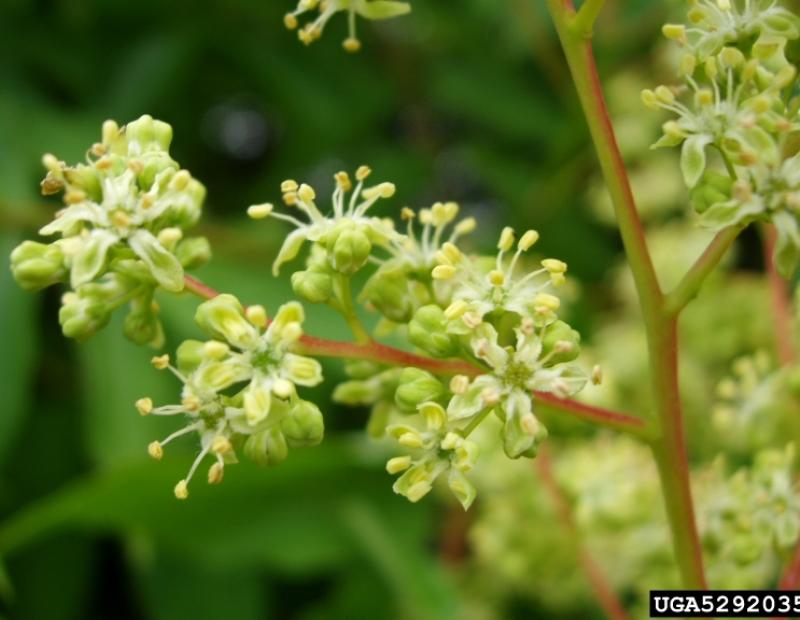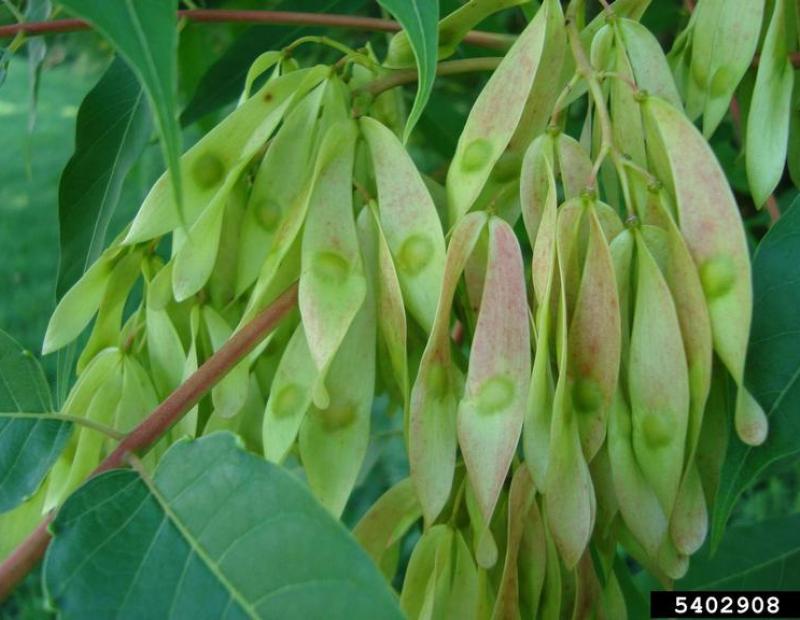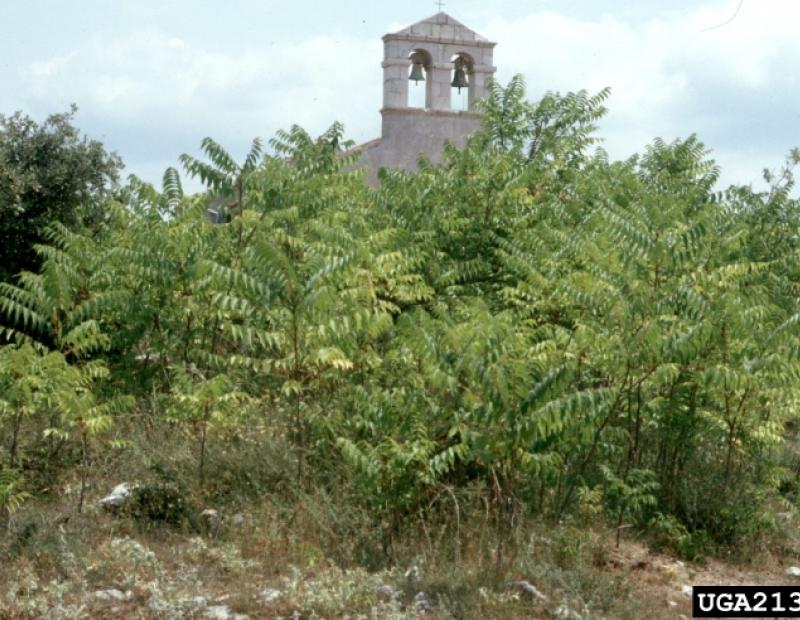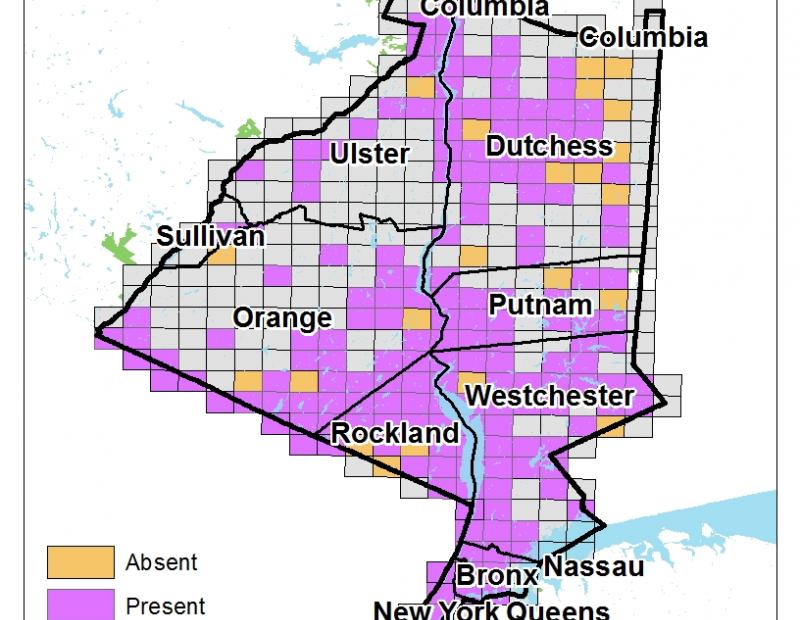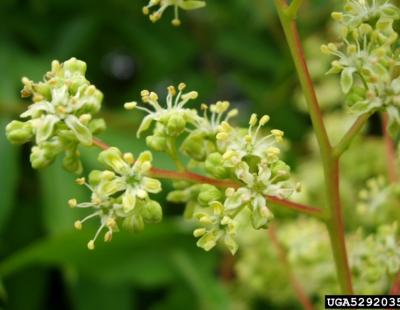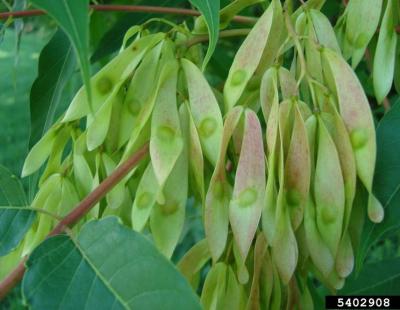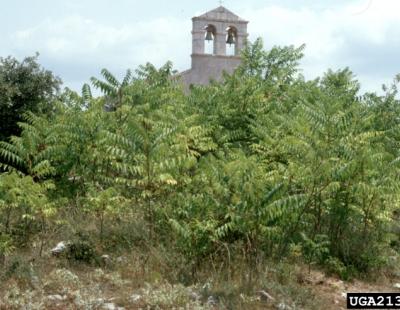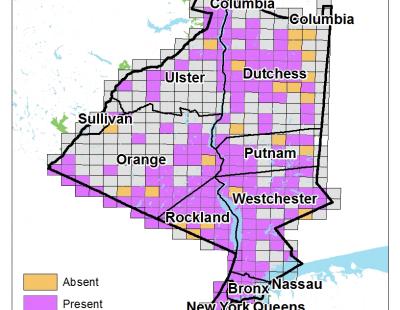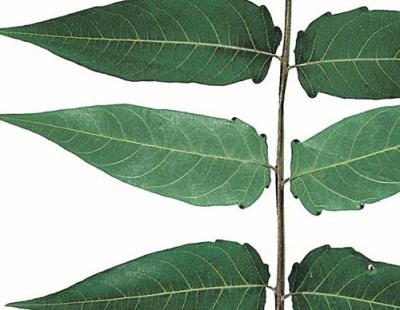Vertical Tabs
A rapidly growing deciduous tree native to China, tree of heaven can grow up to 80 feet in height. The species’ branches are very brittle and easily broken, and its is bark light grey, and smooth. (4) The compound leaves are composed of 10-40 leaflets. Each leaflet has one or a few rounded teeth near its base, and a thickened, round gland on the underside of each tooth. (3) Leaves and stems have a strong, unpleasant odor (likened to rancid peanut butter) when crushed. Yellow-greenish flowers bloom in June and can be seen in dense clusters near the end of the upper stem. In summer and fall, large drooping clusters of winged seeds, called samaras, are visible.
Established stands of this invasive tree can outcompete native species and change the composition and density of the surrounding vegetation, particularly in early successional habitats. (1) The species has been shown to exhibit allelopathic properties and can inhibit the germination and growth of other vegetation. (6)
Biological Control
There is currently no single optimal biological control agent in use against this species.
Manual or Mechanical Control
Pulling / Digging Up: Pulling by hand is an effective method of control for seedlings and small plants if the entire root is extracted from the soil. For larger plants this technique is not advisable as it will encourage root sprouting (4)
Mowing: Not advisable
Girdling: Girdling will top-kill larger trees, however, cut and stump treatment is safer and more effective. Tree of heaven is a very brittle tree: dead standing wood is incredibly hazardous due to its tendency to break apart and fall. (10)
Prescribed Fire: Not applicable. Tree of heaven has a long taproot, rendering it resistant to fire (4)
Prescribed Grazing: White tailed deer and goats will graze tree of heaven foliage, but it is not a preferred species. (4)
Soil Tilling: Not advisable. Tilling may fragment roots and encourage re-sprouting.
Mulching: Not applicable
Solarization: Not applicable
Hot Foam Spray: Not applicable
Chemical Control
The pesticide application rates and usage herein are recommendations based on research and interviews with land managers. When considering the use of pesticides, it is your responsibility to fully understand the laws, regulations and best practices required to apply pesticides in a responsible manner. At times, the pest you seek to treat may not be on a pesticide label, requiring a 2ee exemption from NYSDEC. Always thoroughly read the label of any pesticide and consult the NYSDEC or a licensed pesticide applicator with questions.
Foliar Spray: A 2-3% solution of glyphosate or triclopyr is effective at managing small tree of heaven plants, although a repeat application may be necessary. Infestations managed in this way should be revisited in 2-3 weeks to monitor for regrowth. Always read and follow all instructions on the herbicide label. (10)
Cut Stump: Apply a 50% solution of glyphosate or triclopyr to the cut stump of larger tree of heaven plants towards the end of the growing season, but before leaf senescence. (12)
Basal Bark: A 25% solution of triclopyr applied to the bark of dormant tree of heaven is somewhat effective in controlling infestations, although this technique is best applied with other strategies, such as a follow-up cut stump (12)
Hack-And-Squirt
Stem Injection: Picloram, Imazapyr and Triclopyr are all effective for stem injection use. Midsummer and late winter injections are most effective. Follow information on the product label for appropriate rates and instructions. (12)
Pre-Emergent Spray: Not applicable
General management overview and recommendation
As with any other invasive infestation complex, large stands of tree of heaven are best managed via a combination of mechanical and chemical means. All managed infestations should be monitored for at least one year to ensure exhaustion of the seed bank. (4) Any new seedlings can be hand pulled. Even when using the most effective methods of chemical control, managed populations must be monitored due to the species’ strong tendency to form root sprouts.
Post treatment monitoring
Any infestations managed by chemical means must be revisited in 2-3 weeks to check for treatment efficacy. Any infestations managed solely by mechanical means will need follow up treatment as soon as re-sprouts appear. Populations should be revisited the following year to ensure exhaustion of the short-lived seed bank. (10)
Disposal Methods
Waste material can be crushed, chipped, burned or composted so long as management was completed prior to seed set. Any fruit must be bagged and disposed of, and any roots thoroughly crushed or dried.
REFERENCES
- https://www.researchgate.net/publication/284806443_Removing_the_invasive...
- https://www.eddmaps.org/ipane/ipanespecies/trees/ailanthus_altissima.htm
- https://www.fs.fed.us/database/feis/plants/tree/ailalt/all.html#Botanica...
- http://www.docs.dcnr.pa.gov/cs/groups/public/documents/document/dcnr_010...
- http://www.oardc.ohio-state.edu/weedguide/single_weed.php?id=96
- https://pubs.acs.org/doi/abs/10.1021/jf020686%2B
- https://onlinelibrary.wiley.com/doi/abs/10.1111/j.1600-0706.2009.17941.x
- https://www.invasive.org/silvicsforinvasives.pdf
- https://www.jstor.org/stable/20063745?seq=1#page_scan_tab_contents
- https://www.cabi.org/isc/datasheet/3889
- https://www.fs.usda.gov/Internet/FSE_DOCUMENTS/stelprdb5410131.pdf
- https://www.gri.msstate.edu/ipams/FactSheets/Tree_of_heaven.pdf

